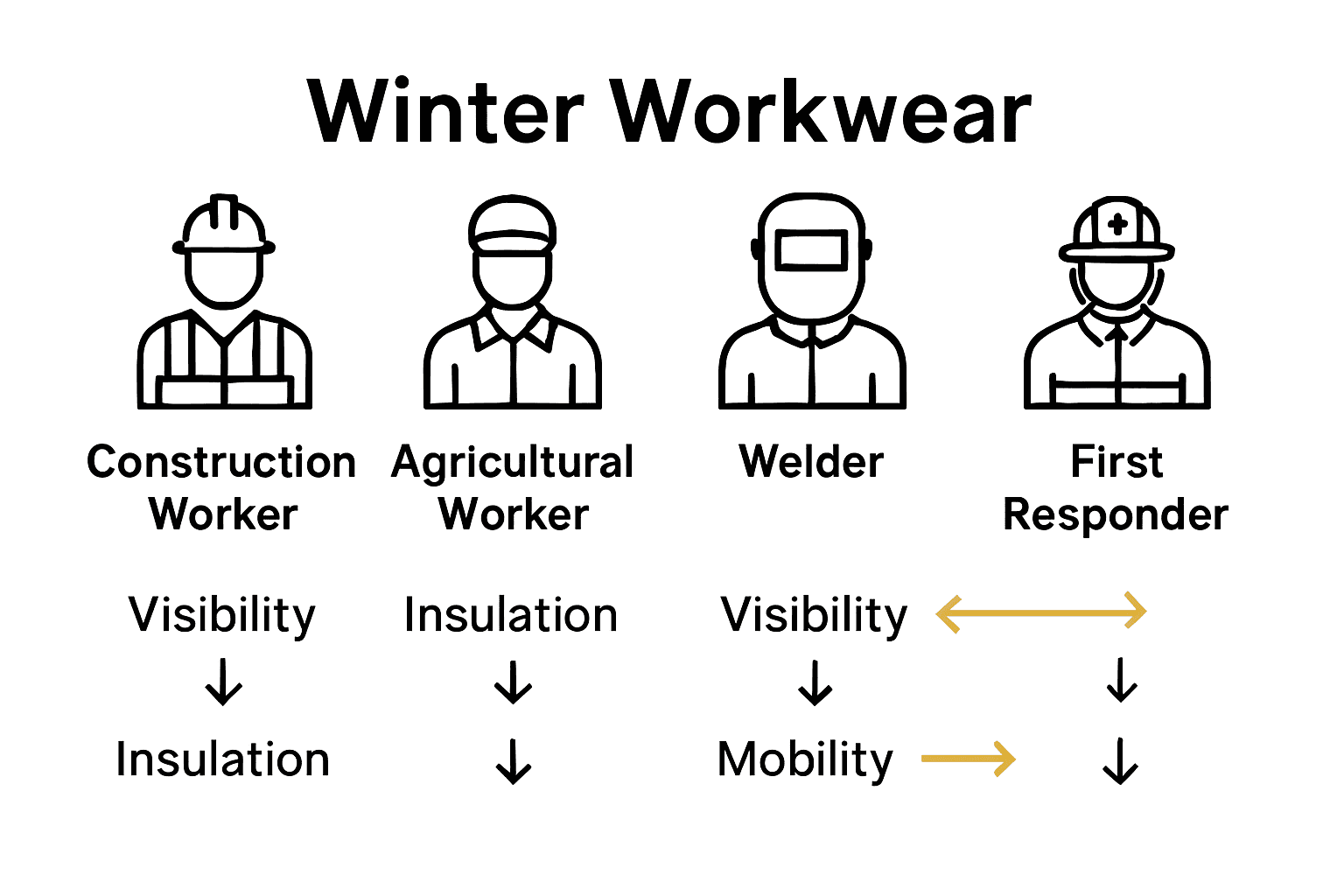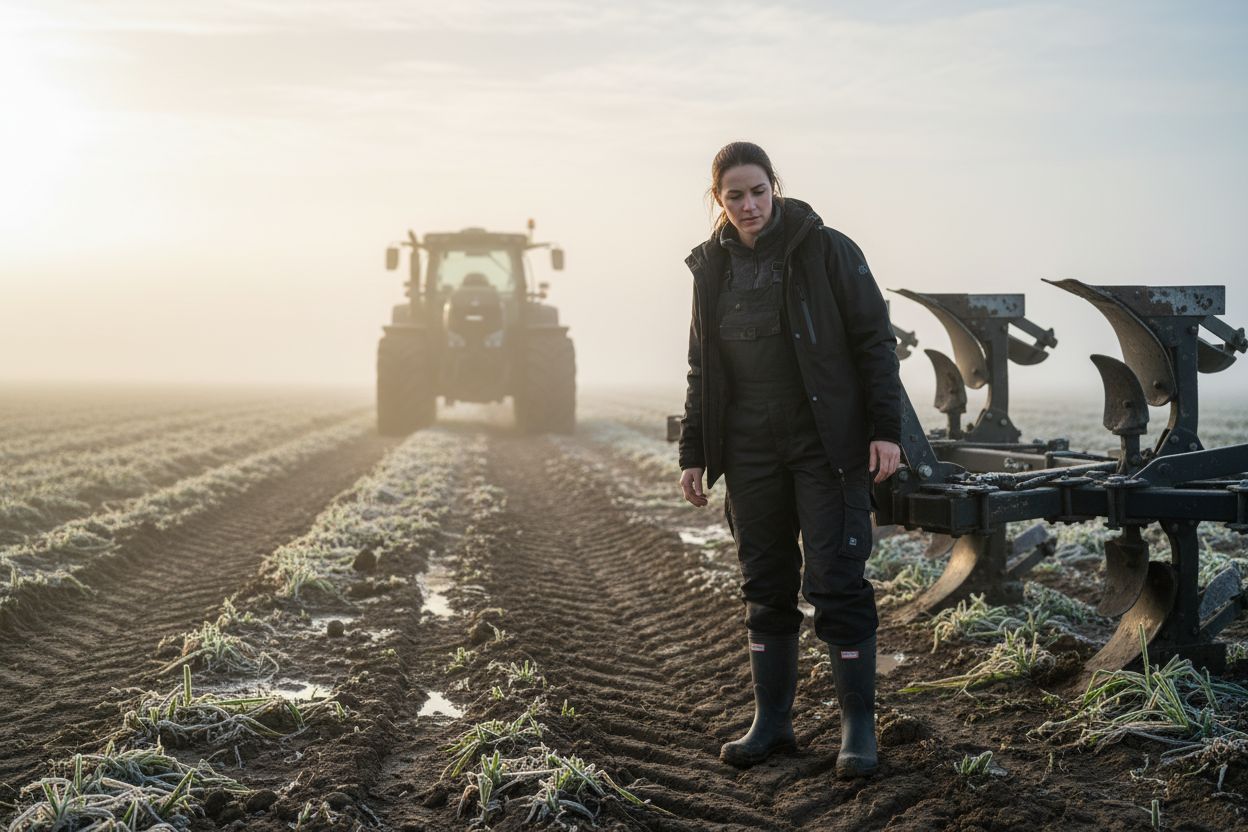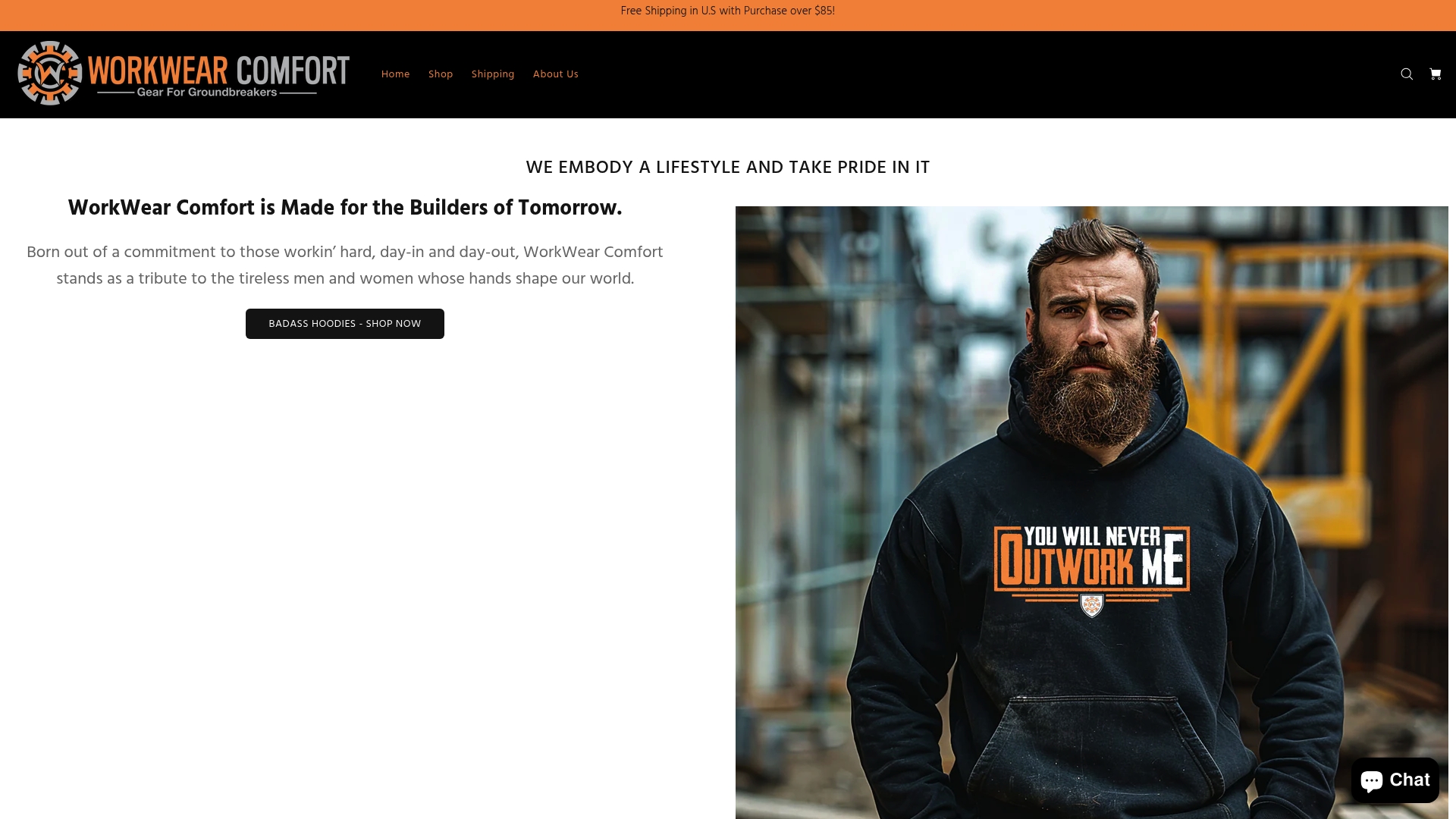Did you know that cold-related illnesses cost U.S. employers over $2 billion annually in lost productivity and medical expenses? Braving the elements is part of the job for millions of outdoor professionals, but the right winter work clothes mean more than beating discomfort. Workers face real risks like frostbite and hypothermia when temperatures drop. Smart solutions in workwear now combine advanced fabrics, strategic layering, and thoughtful design to keep safety and performance front and center during the harshest months.
Key Takeaways
| Point | Details |
|---|---|
| Importance of Winter Work Clothes | Proper winter work attire is critical for preventing cold-related health risks and ensuring occupational safety. |
| COLD Principle for Layering | The COLD principle (Clean, Oversize, Loose, Dry) guides effective clothing choices for managing extreme cold. |
| Job-Specific Winter Wear | Different professions have unique winter clothing requirements tailored for safety and functionality. |
| Common Mistakes in Selection | Avoid prioritizing style over function, improper layering, neglecting visibility, and inadequate footwear when choosing winter workwear. |
Table of Contents
- Defining Winter Work Clothes And Their Importance
- Types Of Winter Workwear For Different Jobs
- Key Insulating Fabrics And Protective Features
- Layering Strategies For Optimal Warmth
- Common Mistakes When Choosing Winter Workwear
Defining Winter Work Clothes and Their Importance
Winter work clothes are more than just fabric and layers. They’re your first line of defense against harsh environmental conditions, transforming challenging work environments into manageable spaces. Occupational safety demands strategic clothing choices that protect workers from cold-related risks while maintaining comfort and mobility.
According to OSHA’s general duty clause, employers must safeguard workers from cold-related hazards like frostbite, trench foot, and hypothermia. This isn’t just about comfort - it’s about survival and prevention. Proper winter work attire becomes critical in environments where temperatures can rapidly compromise worker health and productivity.
The U.S. Army’s extreme cold weather guidance introduces the COLD principle - a strategic approach to winter clothing management:
- Clean: Maintain clothing’s insulative properties
- Oversize: Allow air circulation and movement
- Loose: Prevent restricted blood flow
- Dry: Manage moisture to prevent heat loss
Winter work clothes aren’t uniform across industries. A welder needs different protection than a construction worker, and a farmer requires different considerations compared to a first responder. Our comprehensive workwear guide breaks down these nuanced requirements, ensuring every professional can find their perfect winter work clothing solution.
Types of Winter Workwear for Different Jobs
Winter workwear isn’t one-size-fits-all. Each profession demands specialized thermal protection tailored to unique environmental challenges and job-specific risks. From construction sites to agricultural fields, the right winter clothing can mean the difference between comfort and potential health hazards.
In extreme outdoor environments, workers rely on high-performance gear. According to industry research, specialized jackets like the RefrigiWear HiVis PolarForce Jacket provide critical protection, rated to temperatures as low as −40 °F with wind-tight shells and high-visibility colors. These garments are essential for professionals in construction, industrial settings, and outdoor maintenance roles.
Winter workwear varies significantly across industries:
Here’s a comparison of winter workwear needs for different professions:
| Profession | Key Protection Needs | Typical Winter Workwear |
|---|---|---|
| Construction Worker | Heavy insulation Waterproof High-visibility |
Insulated jackets Waterproof pants Hi-vis vests |
| Agricultural Worker | Mobility Moisture-wicking Durability |
Layered overalls Wool base layers Rubber boots |
| Welder | Flame resistance Thermal protection Dexterity |
Flame-resistant coats Insulated gloves Leather aprons |
| First Responder | Lightweight Quick mobility Adaptability |
Softshell jackets Thermal base layers Reflective tape |
- Construction Workers: Require heavy-duty, waterproof jackets with multiple insulation layers
- Agricultural Workers: Need flexible, moisture-wicking layers that allow freedom of movement
- Welders: Demand flame-resistant materials with additional thermal protection
- First Responders: Prioritize lightweight, adaptable clothing that supports rapid movement
Our comprehensive men’s winter workwear guide offers deeper insights into selecting the perfect winter work attire.
 The key is understanding that effective winter workwear combines protection, comfort, and job-specific functionality - transforming harsh working conditions into manageable environments.
The key is understanding that effective winter workwear combines protection, comfort, and job-specific functionality - transforming harsh working conditions into manageable environments.

Key Insulating Fabrics and Protective Features
Winter workwear technology has dramatically evolved, transforming protective clothing from basic layers to sophisticated performance gear. Modern professionals require intelligent fabric systems that provide warmth, flexibility, and comprehensive protection against extreme environmental conditions.
Thinsulate, developed by 3M, represents a breakthrough in thermal engineering. Used by the U.S. Army since the mid-1980s, this synthetic fiber delivers exceptional heat retention while remaining incredibly lightweight. Workers can now enjoy maximum warmth without the traditional bulk associated with heavy winter clothing, making it a game-changer for professionals who need mobility and comfort.
Key protective features in modern winter workwear include:
- Heat-Reflective Linings: Trap body warmth efficiently
- Breathable Outer Shells: Prevent moisture buildup
- Water-Resistant Materials: Protect against rain and snow
- Thermal Hard Hat Liners: Maintain head temperature in extreme cold
- Anti-Fog Safety Eyewear: Ensure clear vision during challenging conditions
Learn more about flame-resistant clothing for additional protection strategies. The future of winter workwear isn’t just about staying warm—it’s about creating intelligent, adaptive clothing systems that enhance worker safety, comfort, and performance in the most demanding environments.
Layering Strategies for Optimal Warmth
Thermal layering is a science, not just a fashion choice. Professional workers need a strategic approach to clothing that adapts to changing environmental conditions, providing protection without compromising mobility or comfort. Understanding how to layer effectively can mean the difference between enduring harsh winter conditions and struggling through your workday.
According to OSHA-aligned experts, the optimal winter protection follows a three-layer system. Our comprehensive workwear guide breaks down these critical layers:
- Base Layer: Moisture-wicking materials like wool or synthetic fabrics that draw sweat away from the skin
- Mid Layer: Insulating materials such as fleece or wool that trap warm air
- Outer Layer: Waterproof and wind-resistant shells that protect against external elements
The U.S. Army’s extreme cold weather clothing system emphasizes the importance of loose, strategic layering. By allowing space between layers, workers create air pockets that provide additional insulation.
This approach enables quick temperature regulation - adding or removing layers as physical activity and environmental conditions change.
The key is flexibility. Workers in construction, agriculture, or outdoor maintenance need clothing systems that can adapt quickly. Understanding how to choose the perfect hoodie can be your first step in building a versatile winter workwear wardrobe that keeps you warm, dry, and ready for anything the job throws your way.
Common Mistakes When Choosing Winter Workwear
Choosing winter workwear isn’t just about looking good—it’s about survival and performance. Safety-conscious professionals understand that the wrong clothing choices can compromise productivity, comfort, and potentially put workers at serious risk in challenging environments.
According to industry research, workers frequently make critical errors when selecting winter work clothing. Our construction worker gear guide highlights several key mistakes to avoid:
- Prioritizing Style Over Function: Ignoring critical safety certifications like EN 342 for cold protection
- Improper Layering: Creating clothing systems that restrict movement or cause dangerous overheating
- Neglecting Visibility: Skipping high-visibility features essential for worker safety
- Inadequate Footwear: Choosing shoes or boots that don’t provide proper thermal protection
One often-overlooked risk involves eye protection. As research indicates, glare from snow and ice can cause serious conditions like snow blindness (photokeratitis). Workers might have warm clothing but completely miss protecting their eyes—a potentially dangerous oversight. The key is comprehensive protection that considers every aspect of your work environment, from head to toe. Your winter workwear should be a complete system designed to keep you safe, warm, and performing at your best.
Ready for Real Winter Protection? Discover Workwear That Works as Hard as You Do
If you are serious about avoiding common winter workwear mistakes like poor layering, lack of insulation, or choosing style over function, it is time to upgrade your winter essentials. Imagine facing the cold confidently, with gear designed for durability, proper warmth, and complete comfort. Our Blue-Collar Working Man Sweatshirt Hoodies are made to handle tough conditions while still reflecting your identity as someone who values strength and resilience.

Staying warm and safe on the job is not a luxury but a necessity. Do not let inadequate gear slow you down or put your health at risk. Browse our full collection at WorkWear Comfort and experience the peace of mind that comes from apparel built for blue-collar professionals. Want to protect yourself from winter’s harshest days? Start with the right hoodie and step into your next shift ready for anything. Check out our best sellers now and join a community that puts quality and comfort first.
Frequently Asked Questions
What are winter work clothes and why are they important?
Winter work clothes are specialized garments designed to protect workers from harsh environmental conditions during colder months. They help prevent cold-related hazards such as frostbite and hypothermia while ensuring comfort and mobility. Proper attire is crucial for occupational safety in challenging work environments.
How do I effectively layer winter work clothes for optimal warmth?
The optimal layering strategy for winter work involves a three-layer system: a base layer made of moisture-wicking materials, a mid layer for insulation, and an outer layer that is waterproof and wind-resistant. This allows for temperature regulation and flexibility, adapting to changing environmental conditions.
What are some common mistakes to avoid when choosing winter workwear?
Common mistakes include prioritizing style over functionality, improper layering that restricts movement, neglecting high-visibility features, and choosing inadequate footwear. It’s essential to ensure that all pieces of clothing provide comprehensive protection for safety and productivity.
What types of protective features should I look for in winter workwear?
Key protective features include heat-reflective linings that trap warmth, breathable outer shells to prevent moisture buildup, water-resistant materials to protect against rain and snow, and additional items such as thermal hard hat liners and anti-fog safety eyewear to enhance overall protection.


